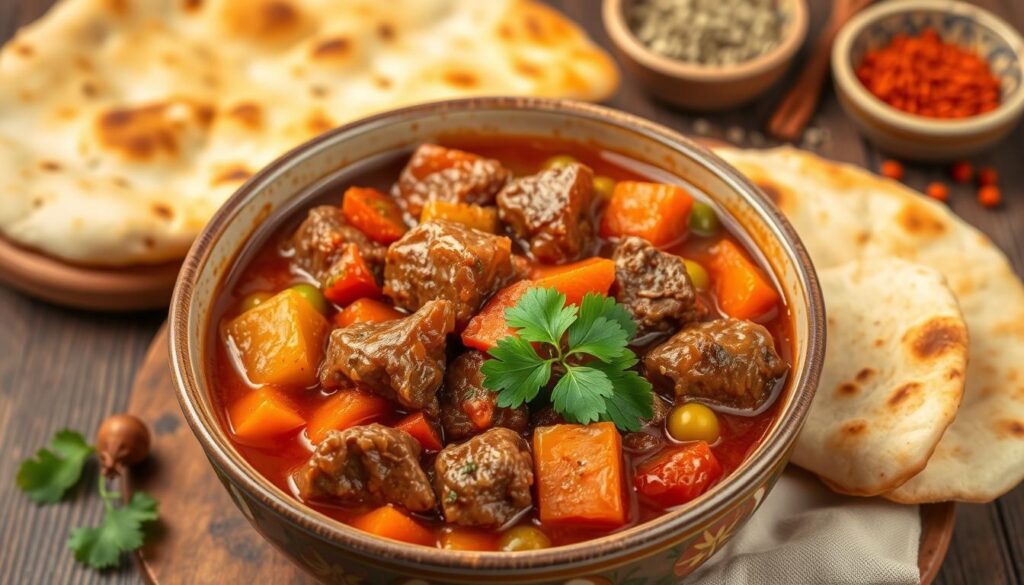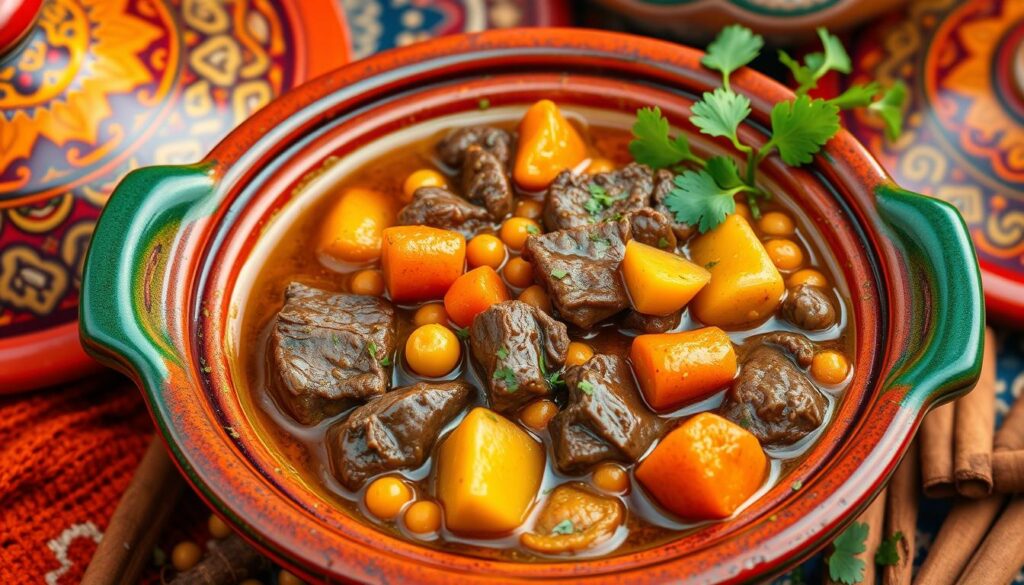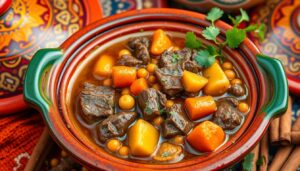I’m excited to take you on a culinary journey through the flavors of North African cuisine. We’ll explore the rich and aromatic world of moroccan beef stew. This traditional african stew is a staple of moroccan cuisine, known for its bold flavors and hearty ingredients.
As we explore the world of moroccan beef stew, we’ll dive into its history and cultural significance. We’ll also look at the essential spices and ingredients that make it unique. Whether you’re a seasoned foodie or just looking to try something new, this article will guide you through the process of creating an authentic moroccan beef stew.

Introduction to Moroccan Cuisine
In this article, we’ll focus on the flavors and techniques that make moroccan beef stew beloved worldwide. We’ll cover the spices, ingredients, cooking methods, and traditional serving suggestions.
Key Takeaways
- Moroccan beef stew is a traditional dish with a rich history and cultural significance
- The stew is known for its bold flavors and hearty ingredients
- Essential spices and ingredients are crucial to creating an authentic moroccan stew
- The cooking method and technique can make or break the dish
- Traditional serving suggestions and accompaniments can enhance the overall experience
- Understanding the basics of moroccan cuisine is key to creating a delicious moroccan beef stew
The Rich Heritage of Moroccan Beef Stew
Exploring moroccan beef, I find its rich cultural background fascinating. This dish comes from North African cuisine, influenced by Arabic, Berber, and French traditions. African spices like cumin, coriander, and cinnamon give it a unique taste, typical of Moroccan cooking.
Preparing moroccan beef stew involves slow-cooking in a clay pot, or tagine. This method blends flavors and tenderizes the meat. It shows the patience and dedication in making an authentic Moroccan stew.
Origins in North African Cuisine
Moroccan beef stew’s history is long and complex, tracing back to ancient North African trade routes. Over time, it has been shaped by various cultures. Today, it symbolizes hospitality and community, often served at celebrations.
Traditional Cooking Methods
To enjoy moroccan beef stew’s true flavors, traditional cooking is key. Slow-cooking in a tagine and using African spices and aromatics are essential. These methods help create a stew that’s both authentic and tasty.

Cultural Significance
Moroccan beef stew is more than food; it’s a symbol of hospitality and community. In Moroccan culture, food brings people together. Serving this stew at gatherings shares the warmth of Moroccan hospitality.
| Ingredient | Quantity |
|---|---|
| Beef | 1 pound |
| African spices | 2 tablespoons |
| Onions | 2 medium |
| Garlic | 3 cloves |
Essential Spices and Ingredients
Preparing an authentic beef tagine requires the right spices and ingredients. Moroccan dishes are famous for their bold flavors. These come from mixing african spices like cumin, coriander, and cinnamon. The smell of these spices makes you eager for the meal.
To make a traditional beef tagine, start with onions, garlic, and ginger. Sauté them in oil to enhance their sweetness. This sweetness balances the spices’ heat. Dried fruits like apricots and prunes add sweetness and chewiness. The beef is then slow-cooked in a flavorful broth.
Some key ingredients in moroccan dishes like beef tagine are:
- Cumin
- Coriander
- Cinnamon
- Ginger
- Onions
- Garlic
- Dried fruits like apricots and prunes
The mix of these spices and ingredients makes beef tagine special. It’s a favorite moroccan dish. Using top-quality african spices and ingredients, you can make a delicious beef tagine. It will take you to Morocco’s lively markets.
Mastering the Art of Moroccan Beef Stew
To make a real Moroccan beef stew, you need to know how to cook with a tagine. This method uses a clay pot with a conical lid. It steams the stew, making the meat tender and the flavors deep.
Start by cutting the meat into small pieces. Then, marinate it in spices and herbs. This step boosts the stew’s flavor. Next, sauté onions, garlic, and spices in oil. Add the meat and broth, letting the flavors mix well.
Preparing the Meat
Here’s how to prepare the meat:
- Cut the meat into small pieces, making sure they are all roughly the same size
- Mix the spices and herbs, including cumin, coriander, and cinnamon, to create a marinade
- Coat the meat in the marinade, making sure it’s evenly covered
By following these steps and using traditional Moroccan cooking, you’ll make a delicious stew. The slow-cooking in a tagine makes the stew tender and flavorful. It’s a true delight of Moroccan cuisine.
Traditional Serving Suggestions and Accompaniments
Serving moroccan dishes, like african stew, is all about the presentation. Serving moroccan beef over fluffy couscous is a traditional favorite. Couscous, made from semolina flour, is often spiced and herbed, enhancing the meal’s flavor.
Couscous is a great match for moroccan beef stew. Its light texture balances the stew’s bold flavors. Adding fresh parsley and lemon juice to the couscous brightens the dish and adds freshness.
Perfect Couscous Pairings
Here are some tips for pairing couscous with your moroccan beef stew:
- Use high-quality semolina flour to make your couscous, as it will have a better texture and flavor.
- Add some sautéed onions and garlic to the couscous for extra flavor.
- Use chicken or vegetable broth instead of water to cook the couscous, as it will add more depth to the dish.
Garnishing Tips
To add elegance to your moroccan beef stew, garnish with fresh herbs like parsley or cilantro. Lemon wedges on the side let guests add a squeeze of fresh lemon juice. These traditional serving suggestions will make your moroccan meal authentic and delicious.
| Ingredient | Quantity |
|---|---|
| Couscous | 1 cup |
| Water or broth | 2 cups |
| Salt | 1 tsp |
Tips for Authentic Tagine Cooking
Exploring moroccan cooking has shown me the beauty of tagine cooking. It’s a key part of african spices and moroccan cuisine. To do it right, you need patience, practice, and to pay close attention to details. Choosing the right ingredients is key, like tender meats, fresh veggies, and aromatic spices.
The type of pot you use is very important for tagine cooking. A traditional tagine is a clay pot with a conical lid. This lid helps the steam fall back into the stew, making it rich and flavorful. To get this effect, use a clay or ceramic pot with a tight lid. Here are some tips for authentic tagine cooking:
- Choose the right ingredients, including tender meats, fresh vegetables, and a blend of aromatic african spices.
- Use a traditional tagine or a clay or ceramic pot with a tight-fitting lid.
- Cook the stew over low heat, allowing the flavors to meld together and the meat to become tender.
By following these tips and techniques, you’ll make delicious and authentic moroccan dishes. Don’t be afraid to try new spice combinations and ingredients.
As you dive into moroccan and tagine cooking, keep trying new things and adjusting recipes to your liking. With time and effort, you’ll master tagine cooking. You’ll make dishes that will wow your friends and family.
| Ingredient | Quantity | Description |
|---|---|---|
| Chicken or beef | 1 pound | Tender meat, cut into bite-sized pieces |
| Onions | 2 medium | Chopped, sautéed until softened |
| African spices | 2 tablespoons | Blend of aromatic spices, including cumin, coriander, and cinnamon |
Conclusion: Embracing the Magic of Moroccan Cuisine
As we end our journey through Moroccan beef stew, it’s clear this dish is more than food. It opens a window into Morocco’s vibrant culture and traditions. Every bite is a taste of the country’s culinary artistry.
If you love food or are just starting to explore, dive into Moroccan cuisine. Try mixing spices and cooking with a tagine. Let the flavors take you to Morocco’s markets and landscapes. Each bite will show you the depth of Moroccan beef stew.
When you cook this African stew, you’re not just making a meal. You’re starting a cultural journey and a sensory adventure. It will change how you taste and feel forever.
FAQ
What is Moroccan Beef Stew?
Moroccan Beef Stew is a flavorful dish from North Africa. It’s made with tender beef, spices, and a rich broth. This stew is slow-cooked to perfection.
What are the essential spices and ingredients in Moroccan Beef Stew?
The key spices in Moroccan Beef Stew are cumin, coriander, cinnamon, and ginger. It also includes onions, garlic, and dried fruits. These ingredients give the stew its unique taste.
How is Moroccan Beef Stew traditionally cooked?
Traditionally, Moroccan Beef Stew is cooked in a clay pot called a tagine. This slow cooking makes the meat tender and the flavors rich.
What are the traditional serving suggestions for Moroccan Beef Stew?
It’s served over couscous, a North African dish made from semolina flour. The stew is garnished with parsley and lemon wedges for extra flavor.
What are some tips for authentic tagine cooking?
For authentic tagine cooking, you need patience and attention to detail. Choose the right ingredients and slow-cook the stew. Let the steam condense back into the dish for a rich broth.
when you try the meal, give us your opinion
reviews
There are no reviews yet. Be the first one to write one.
